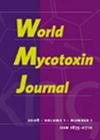墨西哥产牛奶和奶酪中黄曲霉毒素M1污染分析综述
IF 1.7
4区 医学
Q3 FOOD SCIENCE & TECHNOLOGY
引用次数: 1
摘要
由于黄曲霉毒素在食物中存在的致癌特性,这些化合物被认为对人类健康有风险。本系统综述旨在汇编过去二十年来墨西哥生产的牛奶和常见奶酪中黄曲霉毒素M1 (AFM1)检测和定量的现有研究数据。有限数量的研究被发现符合我们综述的目的。只有10项研究集中在牛奶中AFM1含量的评估上,而3项研究分析了瓦哈卡和帕内拉奶酪中这种霉菌毒素的发生。选择HPLC-FD和ELISA检测AFM1。在墨西哥消费的主要乳制品品牌中,发现浓度高于0.5 μg AFM1/kg,这是墨西哥现行食品法规规定的最高限量。对哈利斯科州(2007年)和恰帕斯州(2013年)雨季生产的原料奶的分析显示,霉菌毒素水平在规定范围内,而墨西哥城和墨西哥州(2008年)旱季获得的牛奶样本则超过了这一阈值。对于奶酪,来自韦拉克鲁斯州(2016年)手工生产的瓦哈卡类型样品中有33%和墨西哥城(2019年)获得的样品中有55%被发现超过了牛奶的限量。相比之下,在下加利福尼亚州和瓜纳华托州(2009年)获得的panela奶酪样品符合AFM1法规。此外,在主要牛奶品牌中发现了AFB1及其羟基化代谢物,其浓度可能对人类健康构成高风险。据报道,手工制作和工业生产的瓦哈卡奶酪也有类似的结果。最后,真菌毒素通过喂食受污染饲料的动物进入人类食物链。我们的系统综述表明,迫切需要修改墨西哥现有的食品法规,将真菌毒素作为奶酪中的强效污染物。本文章由计算机程序翻译,如有差异,请以英文原文为准。
Analysis of aflatoxin M1 contamination in milk and cheese produced in Mexico: a review
Due to the carcinogenic character of aflatoxins when present in foods, these compounds are considered a risk to human health. This systematic review aimed at compiling the available research data on detection and quantification of aflatoxin M1 (AFM1) in milk and common types of cheese produced in Mexico in the past two decades. A limited number of studies were found that matched the purpose of our review. Only ten research works focused on the evaluation of AFM1 content in milk while three studies analysed the occurrence of this mycotoxin in oaxaca and panela cheeses. HPLC-FD and ELISA were the methods of choice utilised to detect AFM1. Concentrations higher than 0.5 μg AFM1/kg, a maximum limit set in current food regulation in Mexico, were found in major dairy brands consumed in Mexico. Analysis of raw milk produced during the rainy season in the states of Jalisco (2007) and Chiapas (2013) showed mycotoxin levels within the regulation limits while milk samples obtained during the dry season in the Mexico City and the State of Mexico (2008) exceeded that threshold. For cheeses, 33% of the artisanal produced oaxaca type samples from Veracruz (2016) and 55% of those acquired in Mexico City (2019) were found above the limit set for milk. In contrast, the panela cheese samples obtained in Baja California and Guanajuato (2009) complied with the AFM1 regulation. Additionally, the presence of AFB1 and its hydroxylated metabolites other than AFM1 were determined in the major milk brands at concentrations that could be of high risk for human health. Similar results were reported for both artisan and industrially produced oaxaca cheese. Finally, mycotoxins enter human food chain through animals fed with contaminated fodder. Our systematic review demonstrated the urgent need to amend the existing food regulation in Mexico to include mycotoxins as potent contaminants in cheese.
求助全文
通过发布文献求助,成功后即可免费获取论文全文。
去求助
来源期刊

World Mycotoxin Journal
MYCOLOGY-
CiteScore
4.60
自引率
5.00%
发文量
25
审稿时长
>12 weeks
期刊介绍:
''World Mycotoxin Journal'' is a peer-reviewed scientific journal with only one specific area of focus: the promotion of the science of mycotoxins. The journal contains original research papers and critical reviews in all areas dealing with mycotoxins, together with opinions, a calendar of forthcoming mycotoxin-related events and book reviews. The journal takes a multidisciplinary approach, and it focuses on a broad spectrum of issues, including toxicology, risk assessment, worldwide occurrence, modelling and prediction of toxin formation, genomics, molecular biology for control of mycotoxigenic fungi, pre-and post-harvest prevention and control, sampling, analytical methodology and quality assurance, food technology, economics and regulatory issues. ''World Mycotoxin Journal'' is intended to serve the needs of researchers and professionals from the scientific community and industry, as well as of policy makers and regulators.
 求助内容:
求助内容: 应助结果提醒方式:
应助结果提醒方式:


